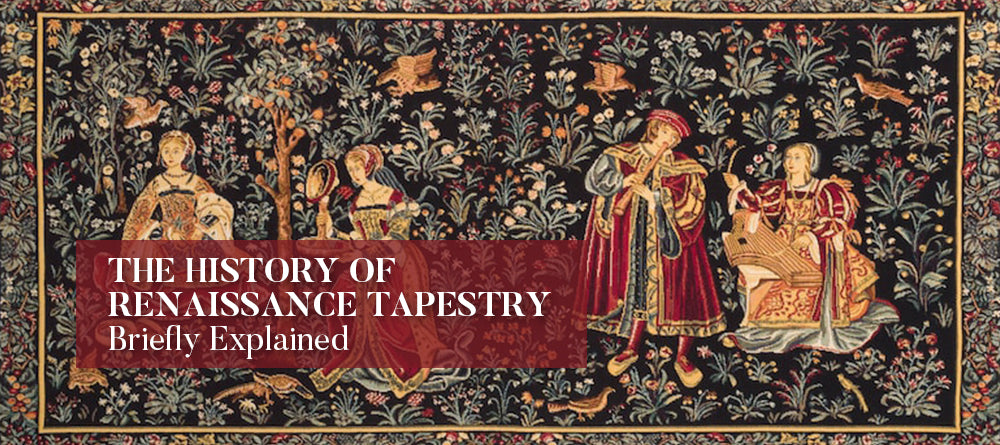
The History Of Renaissance Tapestry: Briefly Explained
The first-ever exhibition that took place in the US highlights a broad survey on tapestry production between the times of the Renaissance in Europe. It usually shows the revolution introduced to tapestry production during the late 15th and first half of the 16th centuries.
This period has witnessed the unsung glory of tapestry, and here the term 'Renaissance" tapestry comes up. During this time, tapestries were considered to be must-have art pieces for royal courts. The kings and others from the royal families promoted the tapestry art form, and tapestries gradually found their place on their walls.

During the time of the Renaissance, few artists and their art forms became popular in the tapestries. Renaissance Tapestries stand out among the many magnificent artifacts from this era because they are masterful works of art that masterfully combine rich thematic richness, colorful perspective, and intricate craftsmanship.
We reveal the fascinating history behind these works of art that graced the halls of royalty and noble residences as we take you on a voyage through the 16th and 17th centuries.
History of Renaissance Tapestry
Renaissance is a time that witnessed a profound change in the style, tradition, and artworks of tapestry—this period revived classical learning, cultural exploration, and innovative interest in the humanities. It accelerated the foundation of an effective tapestry design movement.
During the Renaissance, tapestries were not just pieces of textile art but also became a visual storytelling art form that could convey various stories of war or political affairs, themes, and allegories.
Nowadays, the threads that are used in tapestry weaving are mainly composed of fine wool and fabric materials. However, during the time of the Renaissance, silk fibers were used to create tapestries. Also, silk fibers wrapped in gilt metal were applied to create a premium tapestry.
By adjusting the color of the weft, a pattern or a symbolic image was created by the weavers at first. After that, by using increasingly finer interlocking triangles of color (hatchings or hachures), juxtaposing different materials, and using various techniques to link the weft threads, Flemish weavers created a way to reproduce an extraordinary range of surface textures and painterly effects between 1400 and 1530.
-
Usage Of Colors In Tapestry
The most unique characteristic of Renaissance tapestries is they had an explosion of vibrant colors. The tapestry designs were influenced by a full-scale colored pattern. This is known as cartoon and the practice is still legit nowadays. The weavers of the Renaissance era efficiently employed the color schemes in the tapestries to bring life to their creations. It helped to infuse them with vitality, which allowed them to reflect the spirit of the age.
-
Royalty And Nobility
Royalty and nobility, patrons of the arts, had a significant role in initiating the Renaissance tapestry movement. A common practice was to commission sets of tapestries, each of which told a distinct story. Popular themes included the seasons or the months of the year, enabling these magnificent works of art to function as both decorative accents and pictorial records of the cycles of nature.
-
Diverse Range of Weavers
During the Renaissance period, the creations of French, English, and Flemish weavers were revered for their unique beauty and artistic prowess. Even now, these tapestries are considered to be the most aesthetic, beautiful, and artistic and play the role of a historical testament.
-
A Unique Weaving Method Called Jacquard Weaving
Another weaving method known as Jacquard weaving using premium jacquard looms was introduced during this time. This premium weaving process includes the interweaving of warp and weft yarns to create an unparalleled complex design. Each woven tapestry is an intricate piece of art that requires a great deal of skill and exquisiteness to set up and operate because of these looms.
Conclusion
In conclusion, These beautiful tapestries, which were formerly only found in the rooms of palaces, are now on exhibit in museums all over the world. The attraction of possessing a piece of culture and history, however, never goes away.
The chance to add the greatest pieces of art to one's house demonstrates one's dedication to maintaining the rich legacy of Renaissance tapestries in addition to one's taste.
Because each tapestry is a replica of the greatest works of art in history, it can be placed in any setting because it is available in various sizes. We hope you enjoy the beauty of these Renaissance tapestries and recognize the artistic legacy that has persisted through the ages as you explore their fascinating world.
Visit Home Decor Tapestries and get a chance to add a Renaissance Tapestry to your interior.
Browse Our Other Blogs
